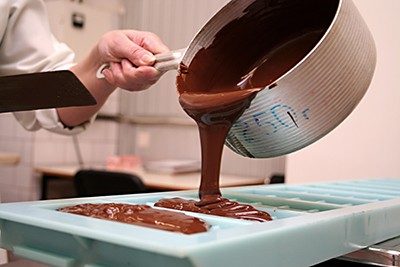FOR IMMEDIATE RELEASE
ACS News Service Weekly PressPac: May 26, 2021
How the mold influences a chocolate bar’s crystalline structure
“Polarized FTIR ATR Spectroscopic Study on the Structure of Chocolate: Influence of Mold on Fat Crystalline Structures”
Crystal Growth & Design
When enjoying a chocolate bar, most people don’t think about how the molecules within it are organized. But different arrangements of the fats in chocolate can influence its taste and texture. Now, researchers reporting in ACS’ Crystal Growth & Design have found that the side of a chocolate bar facing the mold has a more orderly crystalline structure than the side facing air, knowledge that might help chocolatiers produce tastier confections, the researchers say.
Chocolate is a mixture of cocoa solids, cocoa butter, sugar and other ingredients that interact with each other in complex ways. In particular, the fat molecules, or triacylglycerols, can remain liquid or crystallize into several phases with different melting points. The temperature at which a particular chocolate melts affects its taste and texture, with a melting point near body temperature being ideal. When chocolatiers make bars, they pour tempered chocolate into a mold and let it cool at temperatures that favor the most desirable crystal form. Fumitoshi Kaneko and colleagues wondered how the mold, which conveys heat more efficiently than air and also provides a physical barrier, affects fat crystallization.
To find out, the researchers analyzed the structure of fat components at three different positions in a chocolate bar using polarized Fourier transform infrared spectroscopy and attenuated total reflection sampling. They found that the mold-side face of the bar contained highly ordered, regularly packed fatty acid chains, whereas the air-side face had disordered, irregularly packed chains, and the midpoint showed intermediate characteristics. The mold side also contained more of the most desirable fat crystal form than the other locations. These results could be explained by the large difference in thermal conductivity between the mold’s material and air, which causes the chocolate to preferentially cool and crystallize on the mold-side face. The mold also provides a barrier that controls the direction of crystallization, yielding a more orderly arrangement. These results suggest that a chocolate bar’s structure is much less uniform than previously thought, and that improving the crystallization process might lead to better-tasting, melt-in-your-mouth and better-looking chocolate bars, the researchers say.
The authors do not acknowledge any funding sources for this study.
###
The American Chemical Society (ACS) is a nonprofit organization chartered by the U.S. Congress. ACS’ mission is to advance the broader chemistry enterprise and its practitioners for the benefit of Earth and all its people. The Society is a global leader in promoting excellence in science education and providing access to chemistry-related information and research through its multiple research solutions, peer-reviewed journals, scientific conferences, eBooks and weekly news periodical Chemical & Engineering News. ACS journals are among the most cited, most trusted and most read within the scientific literature; however, ACS itself does not conduct chemical research. As a leader in scientific information solutions, its CAS division partners with global innovators to accelerate breakthroughs by curating, connecting and analyzing the world’s scientific knowledge. ACS’ main offices are in Washington, D.C., and Columbus, Ohio.
To automatically receive press releases from the American Chemical Society, contact newsroom@acs.org.
Note: ACS does not conduct research, but publishes and publicizes peer-reviewed scientific studies.
Media Contact
ACS Newsroom
newsroom@acs.org


